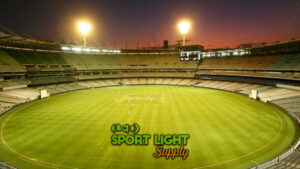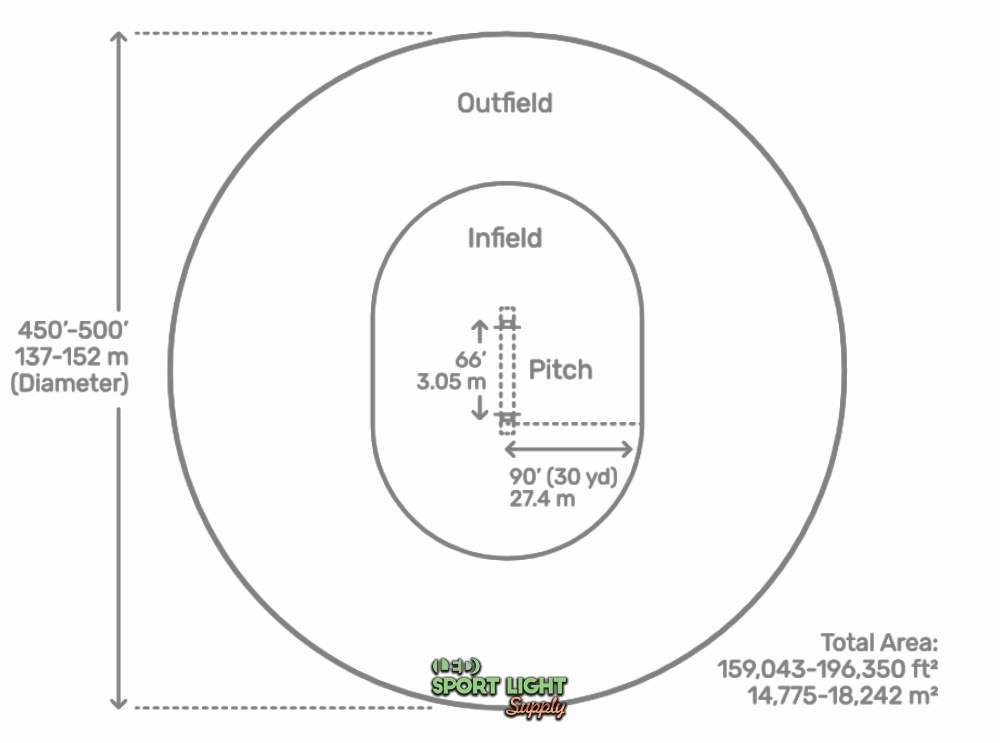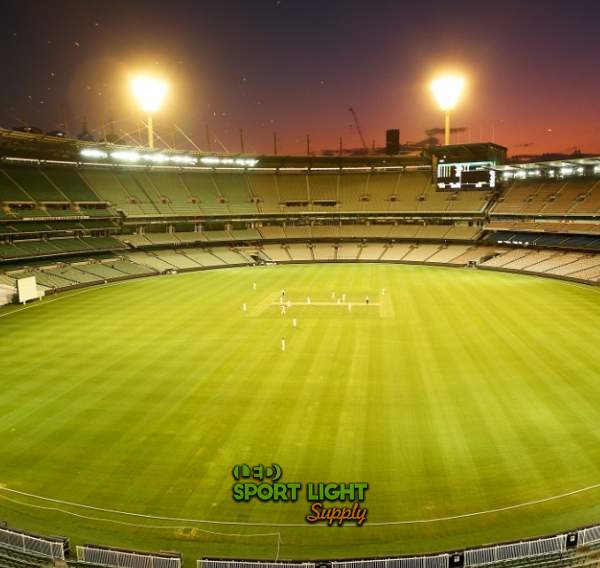
Cricket, known for its tradition and rich history, is a sport that blends strategy, athleticism, and precision. The design of the playing field plays a significant role in shaping the dynamics of the game. From the shape and dimensions of the field to the lighting system used for night games, every detail has an impact on how the sport is played and experienced.

Table of Contents
ToggleThe cricket field is a large oval-shaped area, designed to accommodate the various elements of the game. Its shape and dimensions allow players to demonstrate their skills while offering challenges to both batsmen and fielders. Understanding the basic measurements of a cricket field provides a foundation for appreciating how the game is played.
One of the most recognizable features of a cricket field is the boundary, which marks the outer perimeter of the playing area. This boundary is where batsmen aim to hit the ball to score runs. According to the regulations set by the International Cricket Council (ICC), the distance from the center of the pitch to the boundary should fall within a range of 64 meters (70 yards) to 70 meters (76 yards). This distance is designed to ensure that the playing field remains large enough to accommodate all players while also offering an achievable target for the batsman.
The boundary distance has a significant influence on the dynamics of the game. A smaller boundary encourages more aggressive batting and scoring, while a larger boundary provides fielders with more room to defend. The flexibility of this range allows for variations in the field size depending on the location of the match, the stadium’s dimensions, and the type of game being played.
At the heart of the cricket field lies the cricket pitch. This rectangular strip of turf, where the bowlers deliver the ball and batsmen face it, is central to all the action in the game. The pitch’s dimensions are precisely measured, with a length of 22 yards (20.12 meters) and a width of 10 feet (3.05 meters). These measurements are standardized in professional cricket, providing a consistent environment for players to showcase their skills.
The length of the pitch is particularly relevant to the bowlers and batsmen. A longer pitch can result in more variation in the ball’s trajectory, providing greater opportunities for bowlers to experiment with different deliveries. The width, on the other hand, affects the batsman’s ability to play shots and maneuver the ball, with the narrowness of the pitch encouraging more precise and accurate play.
The area surrounding the pitch is defined by the “inner circle” or the “30-yard circle.” This is an important zone for field placement, as it influences the positions where fielders can stand during different phases of play. The inner circle has a radius of 30 yards (27.43 meters) from the center of the pitch.
This circle plays a key role in the strategy of limited-overs formats like One-Day Internationals (ODIs) and Twenty20 (T20) matches. In these formats, fielding restrictions apply, and the inner circle dictates where fielders can be placed during different stages of the game. For instance, only two fielders are allowed outside the circle in the first 10 overs of an ODI, and a maximum of five fielders are allowed outside the circle for the remainder of the game.
 While the standard dimensions of a cricket field define the physical space, the lighting system significantly enhances the game’s experience, particularly for day-night matches or evening games. The quality of lighting directly impacts the visibility of the game, ensuring that players can perform at their best even when natural light fades.
While the standard dimensions of a cricket field define the physical space, the lighting system significantly enhances the game’s experience, particularly for day-night matches or evening games. The quality of lighting directly impacts the visibility of the game, ensuring that players can perform at their best even when natural light fades.
One of the most significant advancements in the enhancement of cricket fields has been the integration of LED lighting. Unlike traditional lighting methods, such as halogen lamps, LEDs offer superior brightness and more efficient energy use. This results in clearer visibility for both players and spectators, especially as matches extend into the evening or are played under artificial lighting.
LED lights have proven to be much more effective than older lighting technologies. They produce a much brighter and more uniform light, ensuring that every corner of the field is adequately illuminated. This reduces the occurrence of dark spots on the field, which can be problematic in traditional lighting setups. LED lights also provide a more natural light quality, making it easier for players to judge the movement of the ball, whether it’s traveling in the air or bouncing on the pitch.
Energy efficiency is one of the major benefits of LED lighting systems in cricket fields. Traditional lighting systems often consume a large amount of electricity, leading to high operational costs and a greater environmental impact. LEDs, on the other hand, consume significantly less power, which helps reduce the overall energy footprint of the stadium.
The energy savings offered by LED lights can be particularly beneficial for large cricket stadiums, where multiple lights are needed to illuminate the entire playing field. The ability to produce high luminosity without excessive energy consumption is one of the key reasons why LED lighting is becoming the standard for cricket fields worldwide.
Another notable feature of modern LED lighting is the ability to produce a high Color Rendering Index (CRI). The CRI measures how accurately a light source can reproduce the colors of objects when compared to natural light. In cricket, a high CRI is crucial for helping players see the true color of the ball, pitch, and the players themselves.
The cricket ball, especially in formats where it is used in varying lighting conditions, can be difficult to track for players. High-CRI LEDs help enhance the clarity of the ball’s movement, ensuring that batsmen can track the ball more easily and fielders can judge its flight with greater accuracy. This improved visibility helps prevent accidents and ensures that the game can be played at the highest level, even in low-light conditions.
When designing a lighting system for a cricket field, careful consideration is given to the placement of lighting towers and the distribution of lights across the field. Proper light positioning ensures that the entire field is evenly illuminated, providing the best possible environment for the players.
Typically, lighting towers are positioned at the four corners of the cricket field. This strategic placement helps minimize the creation of shadows, ensuring that no part of the field is left in darkness. By positioning the lights at the corners, the floodlights can shine at various angles to cover the field evenly.
In addition to the corner towers, extra lights may be installed along the boundary lines to further reduce shadows and provide continuous illumination across the entire field. This setup not only helps ensure the game can continue smoothly but also enhances the aesthetic appeal of the match for viewers both at the stadium and watching from home.
The number of floodlights required for an optimal cricket field lighting system will vary depending on the size of the field. For a standard cricket field with a boundary distance of 70 meters, it is typical to use 10 to 12 high-intensity floodlights, each rated at 1,000 watts. These high-wattage lights are capable of delivering the necessary brightness to cover the entire playing area.
The distribution of these floodlights ensures that no part of the field remains poorly lit, which could otherwise affect the players’ ability to see the ball and each other. The even distribution of light also prevents the creation of harsh shadows or glaring spots that might distract players during the match.
The height of the lighting towers is also an essential aspect of ensuring that the lighting system is effective. Towers are typically built between 20 and 30 meters in height, with taller towers allowing for a wider spread of light. The height of the towers ensures that the lights cover the entire field evenly without creating shadows or hot spots.
The positioning and height of the towers also help maintain the balance between illuminating the field adequately and minimizing glare, which can be uncomfortable for players and spectators alike. Properly placed lights provide a balanced lighting environment, where players can focus on the game without being hindered by poor visibility.
The design of the field, from the size of the boundary to the specifications of the pitch, directly influences the flow of the match and the strategies employed by players. Meanwhile, the introduction of LED lighting systems has greatly improved the ability to play matches in various lighting conditions, offering enhanced visibility, energy efficiency, and accurate color reproduction. As technology continues to evolve, the integration of advanced lighting systems and thoughtful field design ensures that cricket remains an exciting and dynamic sport for players and spectators alike.
Drop us a line to receive a free lighting design